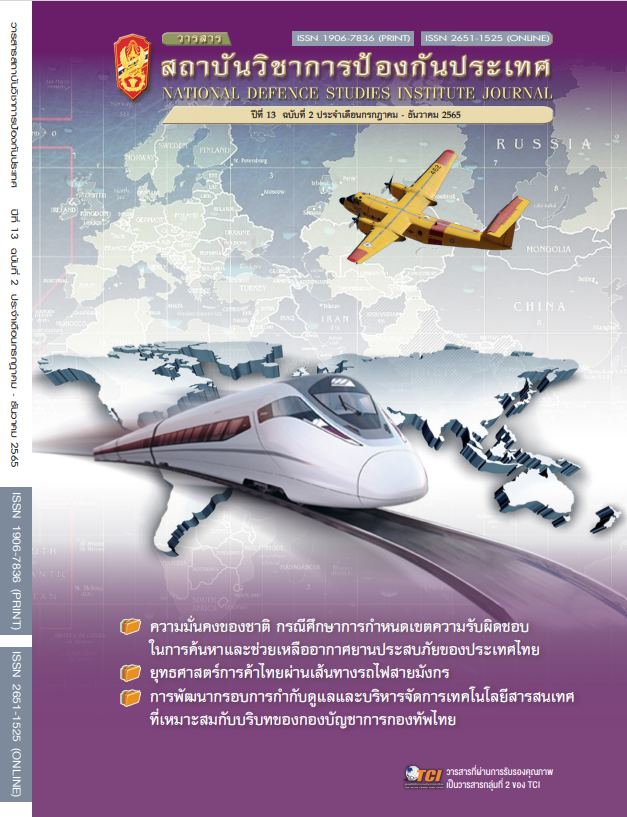Role of Thailand and ASEAN in Dealing with China's Strategic Initiative: the 21st Century Maritime Silk Road
Main Article Content
Abstract
The research aimed to explore the linkage between China’s policy of Belt and Road Initiative (BRI), and the development of the 21st Century Maritime Silk Road, commonly known as Maritime Silk Road (MSR), to investigate its achievements, benefits, and limitations of the cooperative mechanisms under the policy, as well as its effects on Thai economy, society, and culture, and to propose practice of connecting the 21st Century Maritime Silk Road to Thailand and ASEAN. This research was carried out using qualitative methodology through which descriptive analysis was conducted. The research comprised data from both primary and secondary sources. Primary data were obtained from interviews with experts and academics in related fields to discover effects of the 21st Century Maritime Silk Road on Thailand and ASEAN. Secondary data were mostly obtained from textbooks, theses, articles collected from magazines, journals, and electronic media either in Thai and foreign languages.
The results, revealed that China’s Belt and Road Initiative (BRI) emphasized the multilateral cooperation which built economic connectivity across Asia, Africa, and Europe. The 21st Century the CLMVT countries (Cambodia, Laos, Myanmar, and Vietnam) with strategic locations. Building connectivity between the 21st Century Maritime Silk Road and Thailand’s Eastern Economic Corridor in the future will be a win-win strategy for China and Thailand, leading to good relationship between the countries as well as opportunity for social, cultural, and economic cooperation. Therefore, Thailand, with its bilateral agreement with China under the BRI, was recommended to enhance its personnel’s knowledge and understanding of strategies that China implements against other countries and learn lessons as well as effects of the 21st Century Maritime Silk Road on other countries. Finally, cooperative strategies should be thoughtfully and carefully planned for the optimal benefits of Thailand on its journey along the 21st Century Maritime Silk Road.
Article Details

This work is licensed under a Creative Commons Attribution-NonCommercial-NoDerivatives 4.0 International License.
The articles, images, tables, graphs, written content, and opinions published in this journal are solely those of the authors and do not necessarily reflect the views or positions of the National Defence Studies Institute or its academic affiliates.
References
บุญชัย จรัสแสงสมบูรณ์. (2562). แนวทางการสร้างความร่วมมือทางการเงินภายใต้แนวคิดริเริ่มหนึ่งแถบหนึ่งเส้นทางกับความมั่นคง. รัฏฐาภิรักษ์, 61(1). สืบค้นเมื่อ 15 ตุลาคม 2556, จาก so05.tcithaijo.org/index.php/rattapirak/article/view/188930/132393
พงศ์อานันท์ รมยะนันทน์, พล.ต. (2562). การขยายบทบาทของจีนผ่านยุทธศาสตร์ “The Belt and Road Initiative”ผลกระทบต่ออาเซียนและไทย (เอกสารวิจัย). กรุงเทพฯ: วิทยาลัยป้องกันราชอาณาจักร
สถานเอกอัครราชทูตไทย ณ กรุงปักกิ่ง. (2563). ข้อมูลพื้นฐานเศรษฐกิจจีน. สืบค้นเมื่อ 20 ตุลาคม 2565, จาก http://www.thaiembbeij.org/th/republic-of-china/investment/
สถาบันระหว่างประเทศเพื่อการค้าและการพัฒนา (องค์การมหาชน). (2561). โอกาสและผลกระทบภายใต้ความริเริ่ม Belt and Road. สืบค้นเมื่อ 28 กันยายน 2565, จาก https://www.forbesthailand.com/commentaries/belt-and-road
สมาคมการค้าการลงทุนเส้นทางสายไหมไทย-จีน. (2562). สรุปสัมนา “Six Years of the Belt and Road Initiatives: Progress, Contributions and Propects”. สืบค้นเมื่อ 16 ตุลาคม 2565, จาก http://www.tcbri.org/six-years-of-the-belt-and-road-initiatives-progress-contributions-and-prospects/
สุมาลี สุขดานนท์. (2562). ผลกระทบและแนวโน้มการพัฒนาเส้นทางสายไหมใหม่ในศตวรรษที่ 21. สืบค้นเมื่อ 25 กันยายน 2556, จาก http://www.cuti.chula.ac.th/triresearch/saimai21/saimai21.html
สำนักงานการวิจัยแห่งชาติ, ศูนย์วิจัยยุทธศาสตร์ไทย-จีน. (2564).วิเคราะห์สถานการณ์ความเคลื่อนไหวของจีน. กรุงเทพฯ: ศูนย์วิจัย.
Thaipublica. (2561). Connecting Asia ทาบ One Belt, One Road กับ EEC โอกาสร่วมทางยุทธศาสตร์ไทย-จีนเชื่อมโลกเชื่อมไทย 5 ด้าน. สืบค้นเมื่อ 16 ตุลาคม 2565, จาก http://www.thaipublica.org/2017/connecting
Zhahg, W., & สุริยะใส กตะศิลา. (2564). การตอบสนองนโยบาย One Blet One Road ของประเทศไทย.วารสารรังสิตบัณฑิตศึกษาในกลุ่มธุรกิจและสังคมศาสตร์, 7(1), 234-251


